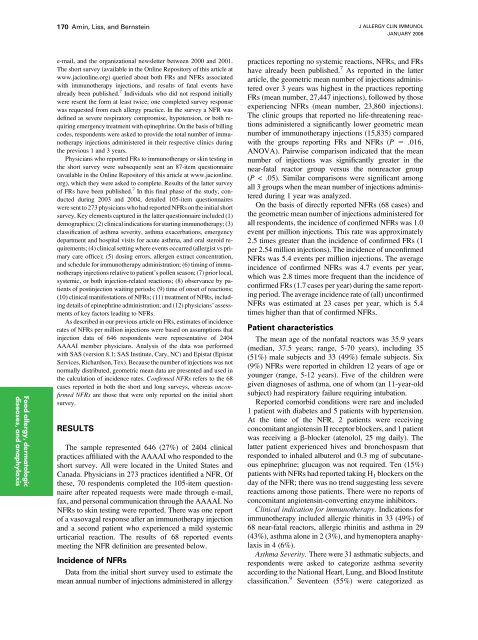Immunotherapy Safety for the Primary Care ... - U.S. Coast Guard
Immunotherapy Safety for the Primary Care ... - U.S. Coast Guard
Immunotherapy Safety for the Primary Care ... - U.S. Coast Guard
Create successful ePaper yourself
Turn your PDF publications into a flip-book with our unique Google optimized e-Paper software.
170 Amin, Liss, and Bernstein<br />
J ALLERGY CLIN IMMUNOL<br />
JANUARY 2006<br />
Food allergy, dermatologic<br />
diseases, and anaphylaxis<br />
e-mail, and <strong>the</strong> organizational newsletter between 2000 and 2001.<br />
The short survey (available in <strong>the</strong> Online Repository of this article at<br />
www.jacionline.org) queried about both FRs and NFRs associated<br />
with immuno<strong>the</strong>rapy injections, and results of fatal events have<br />
already been published. 7 Individuals who did not respond initially<br />
were resent <strong>the</strong> <strong>for</strong>m at least twice; one completed survey response<br />
was requested from each allergy practice. In <strong>the</strong> survey a NFR was<br />
defined as severe respiratory compromise, hypotension, or both requiring<br />
emergency treatment with epinephrine. On <strong>the</strong> basis of billing<br />
codes, respondents were asked to provide <strong>the</strong> total number of immuno<strong>the</strong>rapy<br />
injections administered in <strong>the</strong>ir respective clinics during<br />
<strong>the</strong> previous 1 and 3 years.<br />
Physicians who reported FRs to immuno<strong>the</strong>rapy or skin testing in<br />
<strong>the</strong> short survey were subsequently sent an 87-item questionnaire<br />
(available in <strong>the</strong> Online Repository of this article at www.jacionline.<br />
org), which <strong>the</strong>y were asked to complete. Results of <strong>the</strong> latter survey<br />
of FRs have been published. 7 In this final phase of <strong>the</strong> study, conducted<br />
during 2003 and 2004, detailed 105-item questionnaires<br />
were sent to 273 physicians who had reported NFRs on <strong>the</strong> initial short<br />
survey. Key elements captured in <strong>the</strong> latter questionnaire included (1)<br />
demographics; (2) clinical indications <strong>for</strong> starting immuno<strong>the</strong>rapy; (3)<br />
classification of asthma severity, asthma exacerbations, emergency<br />
department and hospital visits <strong>for</strong> acute asthma, and oral steroid requirements;<br />
(4) clinical setting where events occurred (allergist vs primary<br />
care office); (5) dosing errors, allergen extract concentration,<br />
and schedule <strong>for</strong> immuno<strong>the</strong>rapy administration; (6) timing of immuno<strong>the</strong>rapy<br />
injections relative to patient’s pollen season; (7) prior local,<br />
systemic, or both injection-related reactions; (8) observance by patients<br />
of postinjection waiting periods; (9) time of onset of reactions;<br />
(10) clinical manifestations of NFRs; (11) treatment of NFRs, including<br />
details of epinephrine administration; and (12) physicians’ assessments<br />
of key factors leading to NFRs.<br />
As described in our previous article on FRs, estimates of incidence<br />
rates of NFRs per million injections were based on assumptions that<br />
injection data of 646 respondents were representative of 2404<br />
AAAAI member physicians. Analysis of <strong>the</strong> data was per<strong>for</strong>med<br />
with SAS (version 8.1; SAS Institute, Cary, NC) and Epistat (Epistat<br />
Services, Richardson, Tex). Because <strong>the</strong> number of injections was not<br />
normally distributed, geometric mean data are presented and used in<br />
<strong>the</strong> calculation of incidence rates. Confirmed NFRs refers to <strong>the</strong> 68<br />
cases reported in both <strong>the</strong> short and long surveys, whereas unconfirmed<br />
NFRs are those that were only reported on <strong>the</strong> initial short<br />
survey.<br />
RESULTS<br />
The sample represented 646 (27%) of 2404 clinical<br />
practices affiliated with <strong>the</strong> AAAAI who responded to <strong>the</strong><br />
short survey. All were located in <strong>the</strong> United States and<br />
Canada. Physicians in 273 practices identified a NFR. Of<br />
<strong>the</strong>se, 70 respondents completed <strong>the</strong> 105-item questionnaire<br />
after repeated requests were made through e-mail,<br />
fax, and personal communication through <strong>the</strong> AAAAI. No<br />
NFRs to skin testing were reported. There was one report<br />
of a vasovagal response after an immuno<strong>the</strong>rapy injection<br />
and a second patient who experienced a mild systemic<br />
urticarial reaction. The results of 68 reported events<br />
meeting <strong>the</strong> NFR definition are presented below.<br />
Incidence of NFRs<br />
Data from <strong>the</strong> initial short survey used to estimate <strong>the</strong><br />
mean annual number of injections administered in allergy<br />
practices reporting no systemic reactions, NFRs, and FRs<br />
have already been published. 7 As reported in <strong>the</strong> latter<br />
article, <strong>the</strong> geometric mean number of injections administered<br />
over 3 years was highest in <strong>the</strong> practices reporting<br />
FRs (mean number, 27,447 injections), followed by those<br />
experiencing NFRs (mean number, 23,860 injections).<br />
The clinic groups that reported no life-threatening reactions<br />
administered a significantly lower geometric mean<br />
number of immuno<strong>the</strong>rapy injections (15,835) compared<br />
with <strong>the</strong> groups reporting FRs and NFRs (P 5 .016,<br />
ANOVA). Pairwise comparison indicated that <strong>the</strong> mean<br />
number of injections was significantly greater in <strong>the</strong><br />
near-fatal reactor group versus <strong>the</strong> nonreactor group<br />
(P
















